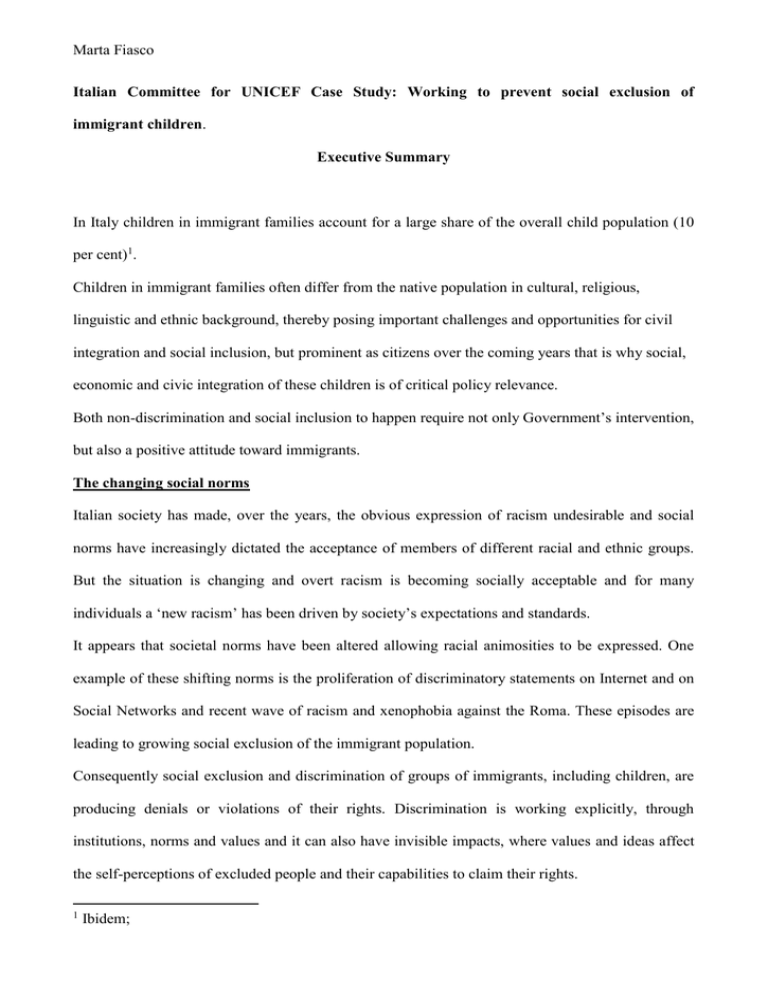Fiasco.Marta - summary
advertisement

Marta Fiasco Italian Committee for UNICEF Case Study: Working to prevent social exclusion of immigrant children. Executive Summary In Italy children in immigrant families account for a large share of the overall child population (10 per cent)1. Children in immigrant families often differ from the native population in cultural, religious, linguistic and ethnic background, thereby posing important challenges and opportunities for civil integration and social inclusion, but prominent as citizens over the coming years that is why social, economic and civic integration of these children is of critical policy relevance. Both non-discrimination and social inclusion to happen require not only Government’s intervention, but also a positive attitude toward immigrants. The changing social norms Italian society has made, over the years, the obvious expression of racism undesirable and social norms have increasingly dictated the acceptance of members of different racial and ethnic groups. But the situation is changing and overt racism is becoming socially acceptable and for many individuals a ‘new racism’ has been driven by society’s expectations and standards. It appears that societal norms have been altered allowing racial animosities to be expressed. One example of these shifting norms is the proliferation of discriminatory statements on Internet and on Social Networks and recent wave of racism and xenophobia against the Roma. These episodes are leading to growing social exclusion of the immigrant population. Consequently social exclusion and discrimination of groups of immigrants, including children, are producing denials or violations of their rights. Discrimination is working explicitly, through institutions, norms and values and it can also have invisible impacts, where values and ideas affect the self-perceptions of excluded people and their capabilities to claim their rights. 1 Ibidem; Marta Fiasco In other words, what is happening according to the Social Norm Theory is a re-categorization of the group ‘immigrant people’. Even if a person has never been offended by an immigrant ha can actually think that every immigrant might be a law offender because is what the mass-medias and the political leaders he trust are saying. That said, there are normative and empirical expectations toward discrimination that are changing for the worst, so to address the problem of discrimination we have to reverse these expectations. How to address negative social norms against immigrants In this context the challenge for the Italian Committee for UNICEF is to promote a rights-based approach emphasizing non-discrimination, inclusion, and empowerment, particularly for vulnerable or marginalized groups of children. The emerging stereotype of immigrant as law offender influences children and adults’ perspectives alike and undermine social norms rejecting discrimination against immigrant people. To start our strategy to overcome the re-categorization of the group ‘immigrant people’ we need to build a new consensus on human rights principles and especially on the principle of nondiscrimination. The idea to implement this strategy would be that the Italian Committee for UNICEF promotes a national awareness campaign on the non-discrimination principle building it on strategic alliances with civil society and with Institutions and media to reach as many people as possible, putting in place an organized diffusion of the information. The architecture of the Campaign should be the following: Promotion of the human rights based approach Build up networks with Institutions Social mobilization National media campaign







